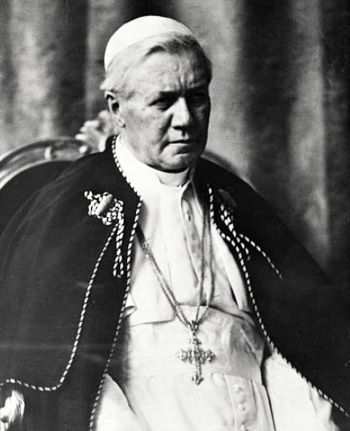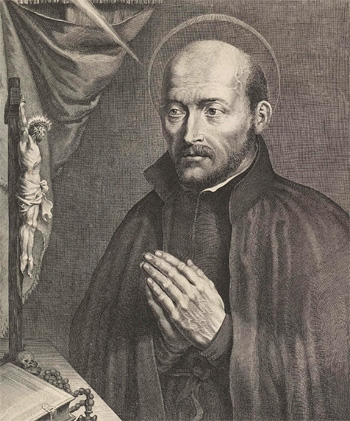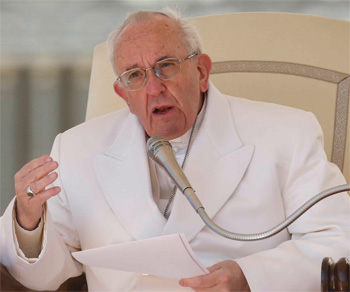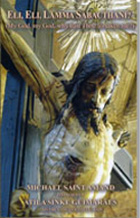Traditionalist Issues
 |
 |
 |
 |
 |
 |
 |
Dialogue Mass - CXXV
Jesuits Tyrrell & Francis Debase the Papacy
In a previous era, it would have been scarcely believable that any member of the Jesuit Order – the only religious order with a solemn vow of obedience to the Pope – would work to undermine the juridical nature of his office as Vicar of Christ and reject his supreme authority in doctrine and morality. When St. Ignatius Loyola inaugurated the Society of Jesus, he included in its Constitutions a requirement for absolute obedience to the Pope and to the Hierarchy under the rubric of “perinde ac cadaver” (like a corpse) i.e., each member of the Order must be as as if he had died to pride, recalcitrance and self-will.
 This did not suit Fr. George Tyrrell’s antinomian character (why he joined such an Order in the first place has never been fully explained), and it is not surprising that he was expelled from it in 1906 for insubordination in refusing to recant his heterodox views. (He was later excommunicated from the Church for his publicly expressed opposition to Pius X’s Pascendi). After Vatican II had adopted Fr. Tyrrell’s positions on Religious Liberty, Ecumenism and Collegiality, we now have a Jesuit Pope who carries on Tyrrell’s work of undermining the Papacy, legislating from the apex of the “triangle” that he pretends has been turned upside down.
This did not suit Fr. George Tyrrell’s antinomian character (why he joined such an Order in the first place has never been fully explained), and it is not surprising that he was expelled from it in 1906 for insubordination in refusing to recant his heterodox views. (He was later excommunicated from the Church for his publicly expressed opposition to Pius X’s Pascendi). After Vatican II had adopted Fr. Tyrrell’s positions on Religious Liberty, Ecumenism and Collegiality, we now have a Jesuit Pope who carries on Tyrrell’s work of undermining the Papacy, legislating from the apex of the “triangle” that he pretends has been turned upside down.
It is not without significance for our topic that, under the influence of Vatican II’s “opening to the world,” the Jesuit Order redefined itself in alignment with worldly causes, including Left-wing socialist and Marxist regimes, especially in Latin America. (1) In short, this overriding concern for “action” within the community meant a complete sea-change in the worldwide Jesuit Order. Instead of the original commitment to spiritual warfare on which the Order was founded, a common characteristic among its members was a preoccupation with “class struggle” in the form of combating socio-economic inequalities and all marks of “superiority” and “privilege.”
A threat to the Constitution of the Church
To locate the source of this form of Liberation Theology – from which Pope Francis has drawn plentifully in his encyclicals and speeches – we must go back to Fr. Tyrrell and the nascent Modernist Movement of the early 20th century. It would be helpful to keep in mind that the liberation sought was not from the clutches of Satan, but from the authority of the Hierarchy which alone possesses the juridical power to loose and bind, and to teach the Faith received from the Apostles.
As we have seen previously, (here and here) for Fr. Tyrrell as well as for all progressivists of our day, the Church’s teaching authority rests with the entire People of God, not with the ordained clergy. Progressivist folklore has it that the pre-Vatican II clergy were guilty of tyrannizing the laity with the imposition of an iron rule. And so they were routinely defamed as “oppressors” simply for exercising their divinely-appointed role as spiritual rulers of the faithful. It is now openly admitted that the desire to liberate the faithful from the constraints of externally imposed authority in matters pertaining to Faith and Morals was the overarching principle of Vatican II. As a result of the Council’s teaching on Religious Liberty, there has been a noticeable shift from concentration on the objective truth contained in the Deposit of the Faith to a subjective search for truth pursued in common with people of all faiths and none.
Freedom to plough one’s own furrow independently of hierarchical authority was advocated by Fr. Tyrrell as a paradigm of modern democracy. It has also been adopted by Pope Francis as the mainspring of his “Synodal Way” in which everything is open to discussion.
Tyrrell & Francis demean the title Vicar of Christ
Like all modernists of the time, Fr. Tyrrell denied the doctrine of papal supremacy in the sense that the Pope is the Vicar of Christ and successor of St. Peter to whom was given the ultimate authority to teach and govern the Church on earth. Instead, he believed that the Hierarchy receives its mandate to govern not from the Pope but from the people to whom it is alone responsible. From there he argued in words that suggested that the power conferred on the priest at ordination is essentially the same as that exercised by the whole community:
“Assuming that the magical conception of priestly power is of the past, I feel that the true repository and source of the power of sacred order is the whole community, which acts through and in its appointed organs; that the difference between, say, a Wesleyan minister and myself is that in him it is the Wesleyan, in me it is the Roman, communion which acts and teaches, and blesses.” (2)
 This erroneous view would, incidentally, become the basis for Vatican II’s Collegiality.
This erroneous view would, incidentally, become the basis for Vatican II’s Collegiality.
Fr. Tyrrell worked strenuously to create and spread what he called “a democratic as opposed to a monarchic conception of the Church’s teaching and ruling authority.” (3) In his view, this meant that “the Pope as Czar and absolute theocratic Monarch by divine right” must “reconcile his headship with the fundamentally democratic character of the Church”; and he must, above all, recognize “the entire Christian people as the true and immediate Vicarius Christi, the only adequate organ of religious development, as that orbis terrarum whose sure verdict is the supreme norm of Faith.” (4)
Now we have Pope Francis taking up the Tyrrell baton, presenting arguments for his “Synodal Way” that lead to the same conclusion: an understanding of the Church as run collectively by the People of God. After reading Fr. Tyrrell’s statement that the people, not the Pope, are the true Vicar of Christ, which makes the Pope only their spokesman, we can understand the underlying meaning of Pope Francis’s famous rhetorical question: “Who am I to judge?” It indicates an abdication of authority and a tacit denial of his universal supremacy insofar as he is avoiding his duty to speak with the authoritative voice of Christ. In other words, he has simply sloughed off the responsibilities of the Pontifical Magisterium in matters of Faith and Morals.
The title Vicar of Christ: now, literally, a footnote in History
Evidence that Pope Francis demonstrated his desire to distance himself from this title – and to renounce his official office as the Vicar of Christ – can be found in the Annuario Pontificio (Pontifical Yearbook), an official Directory or Who’s Who in the worldwide Catholic Church. When the 2020 edition came out, it contained a breach of long-standing Vatican protocol in the form of a significant change on the page dedicated to the reigning Pontiff. This page traditionally began with the title Vicar of Jesus Christ, followed by some of his other customary titles, (5) before mentioning his birth name and brief biographical details. In March 2020, however, the same page had the secular name JORGE MARIO BERGOGLIO blazoned across the top of the page in large capital letters as the first item of information, followed by the usual potted biography.
 But what about the mystery of the disappearing titles, especially the chief one, Vicar of Christ, which had the weightiest doctrinal significance? It would not be accurate to say that the latter was dropped in the same way as Pope Benedict had, for “ecumenical” reasons, struck the papal title “Patriarch of the West” from the Vatican Yearbook in 2006. They remained – with the exception of the latter – but were labelled “historic titles,” and were relegated to a footnote separated by a line from the rest of the page. It was as if they had no longer any relevance to the present day and Pope Francis did not want his name to be personally associated with them. (From the beginning of his Pontificate, Francis only ever wanted to be known as the Bishop of Rome) (6)
But what about the mystery of the disappearing titles, especially the chief one, Vicar of Christ, which had the weightiest doctrinal significance? It would not be accurate to say that the latter was dropped in the same way as Pope Benedict had, for “ecumenical” reasons, struck the papal title “Patriarch of the West” from the Vatican Yearbook in 2006. They remained – with the exception of the latter – but were labelled “historic titles,” and were relegated to a footnote separated by a line from the rest of the page. It was as if they had no longer any relevance to the present day and Pope Francis did not want his name to be personally associated with them. (From the beginning of his Pontificate, Francis only ever wanted to be known as the Bishop of Rome) (6)
If we do a brief linguistic analysis of the vocabulary used in this page of the official Directory and in the words of Pope Francis himself, we see how easily people can be misled by the use of ambiguous keywords. Of course, the term “historic titles” does not necessarily signify discontinuity; but in the post-Vatican II context of radical revision of all things traditional, many will automatically assume that these “historic” titles belong firmly in the past and will not be sorry for their loss. Furthermore, with that mindset, the assumption will be made that these titles no longer have any doctrinal significance. When this point is reached, the victory of the modernists has been achieved and the Faith frittered away.
Regarding the term “Bishop of Rome,” it is true that all the historic titles are subsumed in this one phrase and cannot, in reality, be detached from it. But to use the former while visually separating it from the latter gives the impression that the Pope is just another Bishop, albeit it with extras or embellishments. Above all, no emphasis is given to the title Vicar of Christ that implies his supreme and universal primacy, both of honor and jurisdiction, over all other Bishops and every member of the Church. This sidelining process fits perfectly with the progressivist doctrine of Collegiality invented at Vatican II which places so much emphasis on a democratic reinterpretation of the Pope’s role that, in practice, the traditional understanding of the Petrine Ministry is lost from view.
For Tyrrell & Francis, the monarchical papacy must be brought down
Fr. Tyrrell called the spiritual authority of the papacy a “deadly enemy” (7) of humanity, and stated that “the papacy must either be radically transformed or absolutely sterilized.” (8) Having described himself as “too democratic even to enjoy the ‘superiority’ of sacerdotal dignity,” he registered his undying hatred of Rome with the words:
“A Roman collar always chokes me, though I wear it still for propriety’s sake.” (9)
Who can deny that this attitude has reached epidemic proportions among the progressivist clergy since Vatican II? They have in large numbers cast aside the Roman collar as a relic of what they term the old “Clericalism” inherited from the Tridentine era. Fr. Tyrrell revealed what lies behind this anti-Roman gesture in 1908, with his customary outspokenness:
“Needless to say that I entirely deny the ecumenical authority of the exclusively Western Councils of Trent and the Vatican and the whole medieval development of the Papacy so far as claiming more than a primacy of honor for the Bishop of Rome.” (10)
We can safely infer from the writings, sermons and actions of a broad swathe of Novus Ordo clergy that this essentially Protestant denial still prevails, even though not expressed in such explicit terms. The doctrinal orthodoxy guaranteed by Trent and Vatican I is now in disarray; and not a single one of the Tiara-tossing Popes from Vatican II onwards has been willing to uphold the monarchical status of the Papacy.
Continued

Tyrrell was excommunicated for rejecting St. Puis X teaching on Modernism
It is not without significance for our topic that, under the influence of Vatican II’s “opening to the world,” the Jesuit Order redefined itself in alignment with worldly causes, including Left-wing socialist and Marxist regimes, especially in Latin America. (1) In short, this overriding concern for “action” within the community meant a complete sea-change in the worldwide Jesuit Order. Instead of the original commitment to spiritual warfare on which the Order was founded, a common characteristic among its members was a preoccupation with “class struggle” in the form of combating socio-economic inequalities and all marks of “superiority” and “privilege.”
A threat to the Constitution of the Church
To locate the source of this form of Liberation Theology – from which Pope Francis has drawn plentifully in his encyclicals and speeches – we must go back to Fr. Tyrrell and the nascent Modernist Movement of the early 20th century. It would be helpful to keep in mind that the liberation sought was not from the clutches of Satan, but from the authority of the Hierarchy which alone possesses the juridical power to loose and bind, and to teach the Faith received from the Apostles.
As we have seen previously, (here and here) for Fr. Tyrrell as well as for all progressivists of our day, the Church’s teaching authority rests with the entire People of God, not with the ordained clergy. Progressivist folklore has it that the pre-Vatican II clergy were guilty of tyrannizing the laity with the imposition of an iron rule. And so they were routinely defamed as “oppressors” simply for exercising their divinely-appointed role as spiritual rulers of the faithful. It is now openly admitted that the desire to liberate the faithful from the constraints of externally imposed authority in matters pertaining to Faith and Morals was the overarching principle of Vatican II. As a result of the Council’s teaching on Religious Liberty, there has been a noticeable shift from concentration on the objective truth contained in the Deposit of the Faith to a subjective search for truth pursued in common with people of all faiths and none.
Freedom to plough one’s own furrow independently of hierarchical authority was advocated by Fr. Tyrrell as a paradigm of modern democracy. It has also been adopted by Pope Francis as the mainspring of his “Synodal Way” in which everything is open to discussion.
Tyrrell & Francis demean the title Vicar of Christ
Like all modernists of the time, Fr. Tyrrell denied the doctrine of papal supremacy in the sense that the Pope is the Vicar of Christ and successor of St. Peter to whom was given the ultimate authority to teach and govern the Church on earth. Instead, he believed that the Hierarchy receives its mandate to govern not from the Pope but from the people to whom it is alone responsible. From there he argued in words that suggested that the power conferred on the priest at ordination is essentially the same as that exercised by the whole community:
“Assuming that the magical conception of priestly power is of the past, I feel that the true repository and source of the power of sacred order is the whole community, which acts through and in its appointed organs; that the difference between, say, a Wesleyan minister and myself is that in him it is the Wesleyan, in me it is the Roman, communion which acts and teaches, and blesses.” (2)

Francis & Tyrrell, two Jesuits against the spirit of St. Ignatius of Loyola
Fr. Tyrrell worked strenuously to create and spread what he called “a democratic as opposed to a monarchic conception of the Church’s teaching and ruling authority.” (3) In his view, this meant that “the Pope as Czar and absolute theocratic Monarch by divine right” must “reconcile his headship with the fundamentally democratic character of the Church”; and he must, above all, recognize “the entire Christian people as the true and immediate Vicarius Christi, the only adequate organ of religious development, as that orbis terrarum whose sure verdict is the supreme norm of Faith.” (4)
Now we have Pope Francis taking up the Tyrrell baton, presenting arguments for his “Synodal Way” that lead to the same conclusion: an understanding of the Church as run collectively by the People of God. After reading Fr. Tyrrell’s statement that the people, not the Pope, are the true Vicar of Christ, which makes the Pope only their spokesman, we can understand the underlying meaning of Pope Francis’s famous rhetorical question: “Who am I to judge?” It indicates an abdication of authority and a tacit denial of his universal supremacy insofar as he is avoiding his duty to speak with the authoritative voice of Christ. In other words, he has simply sloughed off the responsibilities of the Pontifical Magisterium in matters of Faith and Morals.
The title Vicar of Christ: now, literally, a footnote in History
Evidence that Pope Francis demonstrated his desire to distance himself from this title – and to renounce his official office as the Vicar of Christ – can be found in the Annuario Pontificio (Pontifical Yearbook), an official Directory or Who’s Who in the worldwide Catholic Church. When the 2020 edition came out, it contained a breach of long-standing Vatican protocol in the form of a significant change on the page dedicated to the reigning Pontiff. This page traditionally began with the title Vicar of Jesus Christ, followed by some of his other customary titles, (5) before mentioning his birth name and brief biographical details. In March 2020, however, the same page had the secular name JORGE MARIO BERGOGLIO blazoned across the top of the page in large capital letters as the first item of information, followed by the usual potted biography.

A common overcoat, no Pectoral Cross, no visible cassock: Pope Francis dressing as a layman
If we do a brief linguistic analysis of the vocabulary used in this page of the official Directory and in the words of Pope Francis himself, we see how easily people can be misled by the use of ambiguous keywords. Of course, the term “historic titles” does not necessarily signify discontinuity; but in the post-Vatican II context of radical revision of all things traditional, many will automatically assume that these “historic” titles belong firmly in the past and will not be sorry for their loss. Furthermore, with that mindset, the assumption will be made that these titles no longer have any doctrinal significance. When this point is reached, the victory of the modernists has been achieved and the Faith frittered away.
Regarding the term “Bishop of Rome,” it is true that all the historic titles are subsumed in this one phrase and cannot, in reality, be detached from it. But to use the former while visually separating it from the latter gives the impression that the Pope is just another Bishop, albeit it with extras or embellishments. Above all, no emphasis is given to the title Vicar of Christ that implies his supreme and universal primacy, both of honor and jurisdiction, over all other Bishops and every member of the Church. This sidelining process fits perfectly with the progressivist doctrine of Collegiality invented at Vatican II which places so much emphasis on a democratic reinterpretation of the Pope’s role that, in practice, the traditional understanding of the Petrine Ministry is lost from view.
For Tyrrell & Francis, the monarchical papacy must be brought down
Fr. Tyrrell called the spiritual authority of the papacy a “deadly enemy” (7) of humanity, and stated that “the papacy must either be radically transformed or absolutely sterilized.” (8) Having described himself as “too democratic even to enjoy the ‘superiority’ of sacerdotal dignity,” he registered his undying hatred of Rome with the words:
“A Roman collar always chokes me, though I wear it still for propriety’s sake.” (9)
Who can deny that this attitude has reached epidemic proportions among the progressivist clergy since Vatican II? They have in large numbers cast aside the Roman collar as a relic of what they term the old “Clericalism” inherited from the Tridentine era. Fr. Tyrrell revealed what lies behind this anti-Roman gesture in 1908, with his customary outspokenness:
“Needless to say that I entirely deny the ecumenical authority of the exclusively Western Councils of Trent and the Vatican and the whole medieval development of the Papacy so far as claiming more than a primacy of honor for the Bishop of Rome.” (10)
We can safely infer from the writings, sermons and actions of a broad swathe of Novus Ordo clergy that this essentially Protestant denial still prevails, even though not expressed in such explicit terms. The doctrinal orthodoxy guaranteed by Trent and Vatican I is now in disarray; and not a single one of the Tiara-tossing Popes from Vatican II onwards has been willing to uphold the monarchical status of the Papacy.
Continued
- It is well known that Jesuits, for example Fr. Fernando Cardenal, participated in the communist-backed Sandinista government of Nicaragua.
- George Tyrrell, ‘To Bishop Vernon Herford’, April 14, 1907, George Tyrrell and Maude Petre, George Tyrrell’s Letters, New York: E.P. Dutton, 1920, p. 112.
- Ibid., p. 100.
- G. Tyrrell, The Church and the Future, London: Priory Press, 1910, p. 103
- “Successor of the Prince of the Apostles, Supreme Pontiff of the Universal Church, Primate of Italy, Archbishop and Metropolitan of the Province of Rome. Sovereign of Vatican City State, Servant of the Servants of God”
- This was evident from the moment he steeped on the balcony after his election on March 13, 2013. His first words to the public were: “Brothers and sisters, good evening. You all know that the duty of the conclave was to give a Bishop to Rome. It seems that my brother cardinals have gone almost to the ends of the earth to get him ... but here we are”.
- G. Tyrrell, Medievalism, a Reply to Cardinal Mercier, London: Longmans, Green and Co., 1908, p. 135.
- G. Tyrrell, ‘To Monsieur J. Augustin Leger’, November 8, 1908, George Tyrrell’s Letters, New York: E.P. Dutton, 1920, p. 97.
- ‘To Wilfrid Ward Esq.’, April 8, 1906, op. cit., p.102.
- G. Tyrrell, ‘Letter to Herzog’, November 4, 1908, Autobiography and Life Of George Tyrrell, Vol. 2, 1912, p. 383.
Posted April 19, 2023
______________________
______________________
 Volume I |
 Volume II |
 Volume III |
 Volume IV |
 Volume V |
 Volume VI |
 Volume VII |
 Volume VIII |
 Volume IX |
 Volume X |
 Volume XI |
 Special Edition |